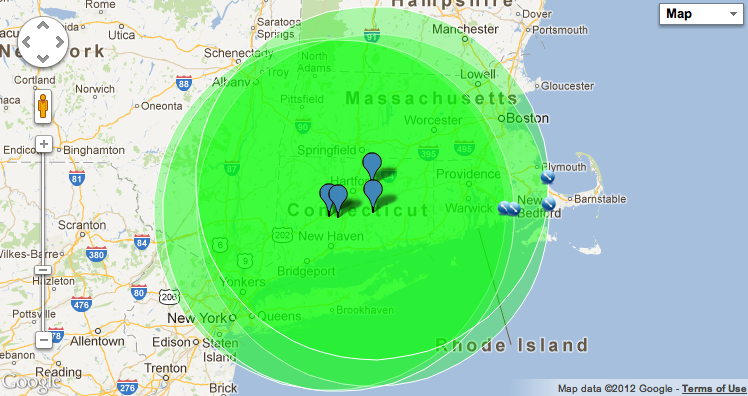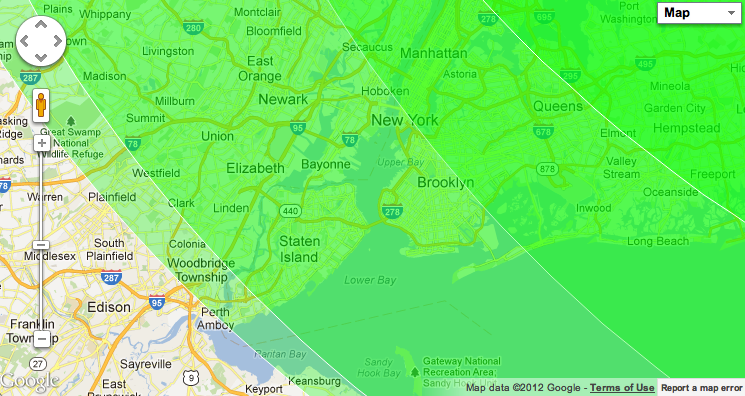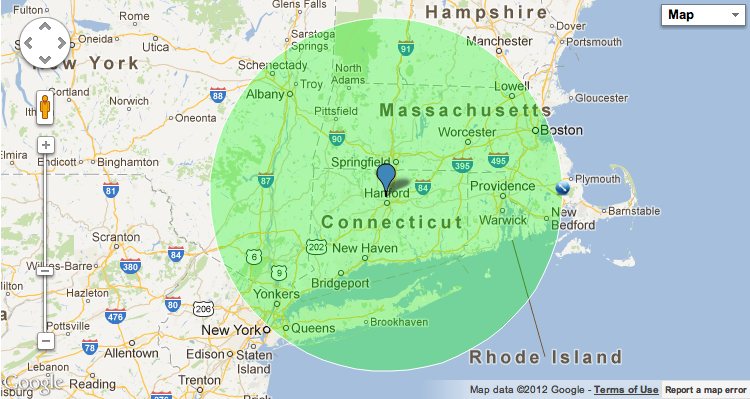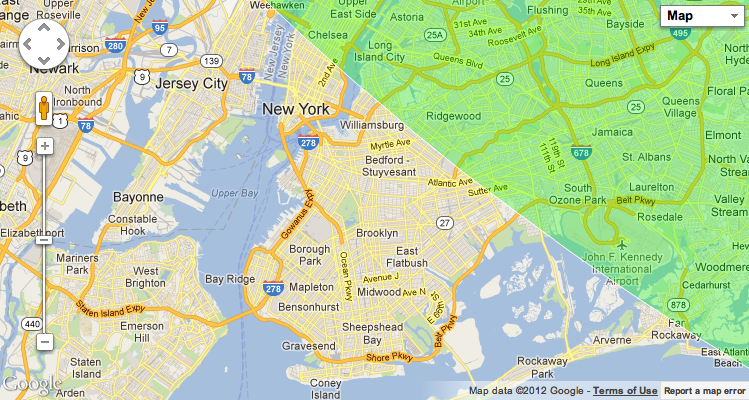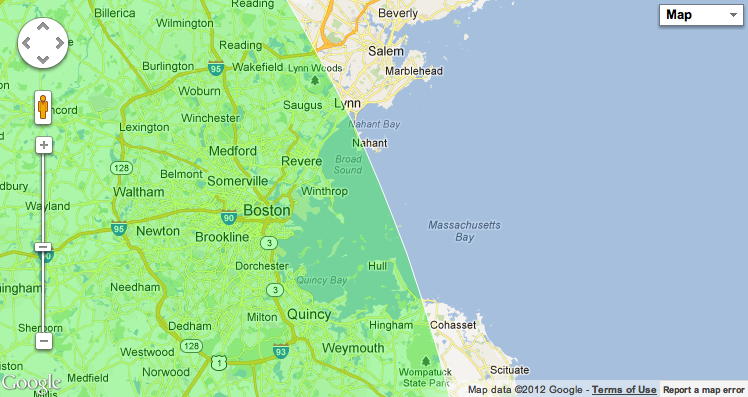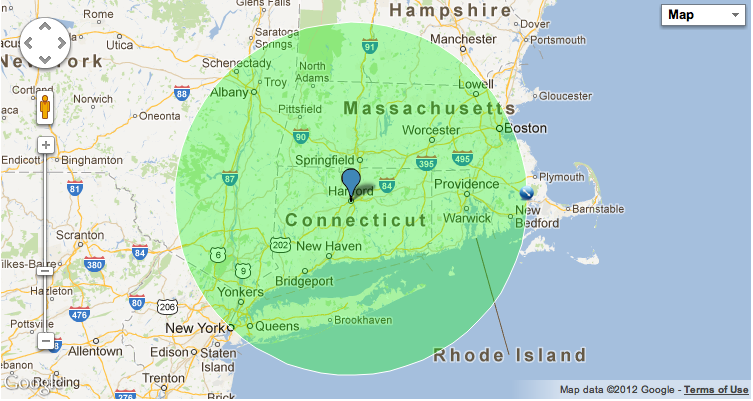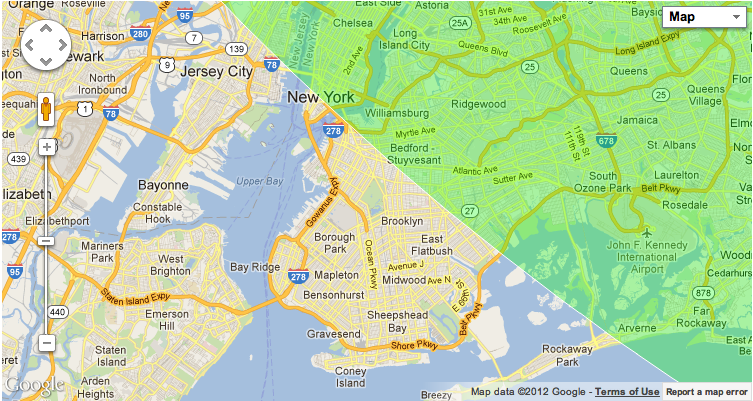July 16, 2012 by Charlie Eisenhood in Analysis, News with 3 comments
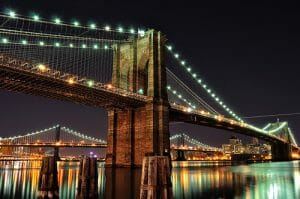 After analyzing the Connecticut Constitution’s licensing agreement with the American Ultimate Disc League, commenters raised some important points about the team’s “defined territory” and the 100-mile radius around it in which the league cannot set up new teams.
After analyzing the Connecticut Constitution’s licensing agreement with the American Ultimate Disc League, commenters raised some important points about the team’s “defined territory” and the 100-mile radius around it in which the league cannot set up new teams.
In our initial coverage, we created a map with the center point of the radius in New Bristol, CT, the location of the home stadium of the Constitution. That was incorrect. Our legal analyst will explain more, but it appears that the territory is actually in Hartford County.
This is an important distinction. Depending on how you draw the map (which is open to interpretation as it is not specified in the license agreement), there are areas of both New York and Boston which fall outside of the 100 mile radius, which opens a legal avenue for the league to place a new franchise in those cities. (Remember that the Rhode Island Rampage are included in this lawsuit and their protected territory without a doubt includes Boston).
Indeed, the league itself has made that case. On their Facebook page, they responded to a commenter by saying “the agreement doesn’t say there can’t be a NYC team, just 100 miles from Hartford, so there have not been contract violations despite what you may have read about elsewhere.”
Ultiworld’s legal analyst, a rising third year law student who works in contract law, explains the situation below. It is not legal advice and should not be used to replace consultation with a trained legal professional.
*
The contract itself is (yet again) a bit vague on the area issue. In the same section, it appears to define both “Hartford CT” (presumably the city) and “Hartford County CT” as the Constitution’s area (Recital C and D, page 2).
My reading of it is that the league issues a license to an area known as “Hartford CT,” but that is technically defined as Hartford County (Recital C and D, page 2).
Further complicating matters, the contract switches back and forth between the term “area” and the term “territory.” Somewhat circularly, the “Defined Territory” appears to be defined as the “Hartford CT area,” (Section 1.A.1) but, again, that term appears to be defined as Hartford County.
Section Five says that the league will not engage in a variety of activities within a 100 mile radius of “the defined Territory or any other territory of Licensee.”
The big question here is where (and what) the protected territory is. My hesitant conclusion is that the defined territory is Hartford County, CT; still, where exactly is the radius drawn from? The contract should be specific but isn’t. I see at least three options, which I rank in the order that I perceive to be the strongest:
1. The entirety of Hartford County is the territory, and every single border of the county gets a 100-mile radius from that point.
2. Whatever is roughly the middle of Hartford County is the territory, and the 100-mile radius comes from that point.
3. Hartford (the city) the territory because it is arguably referenced in the Recitals section, and the 100-mile radius comes from the city.
As you can see, Argument 1 is clearly most favorable to the Constitution. The basis would be that it is probably the most literal interpretation of the Agreement (there is no reason territory has to be a single specific point). Arguments 2 and 3 are pretty similar and might be wins for the League if they put the New York City franchise outside of the radius. I can imagine a court saying that option 3 was probably the parties’ intent based on the Recitals (and that it was sloppily drafted) or that option 2 is a reasonable filler for a term (“territory”) which isn’t precisely defined.
Finally we come to the question of “What if some part of New York is outside the radius and some part is within?” Can the league manage not to “establish…, run, and/or operate…” a team within the radius while still tapping the New York market?
‘Establish’ probably has the narrowest meaning in this context (the team is established in whatever area/territory the league licenses, which could be a small and distant point in Brooklyn). But you have to think that hosting tryouts or games in the Constitution’s protected territory would count as either running or operating a team, putting them in violation of the contract. Marketing the team in the protected area while technically playing and operating outside the radius would be the razor-edge point where you could argue it either way.
I think, all-in-all, the takeaway here remains vast uncertainty. We can highlight the issues and language which will be important but there are tons of arguments on both sides. I continue to hold the opinion that many of the borderline issues cut slightly in favor of the Constitution, but this has the potential to be a very messy and lengthy litigation. Let’s hope it doesn’t come to it and let’s hope that the league clarifies these contacts before next season.
Photo via Flickr user andrew c mace.
